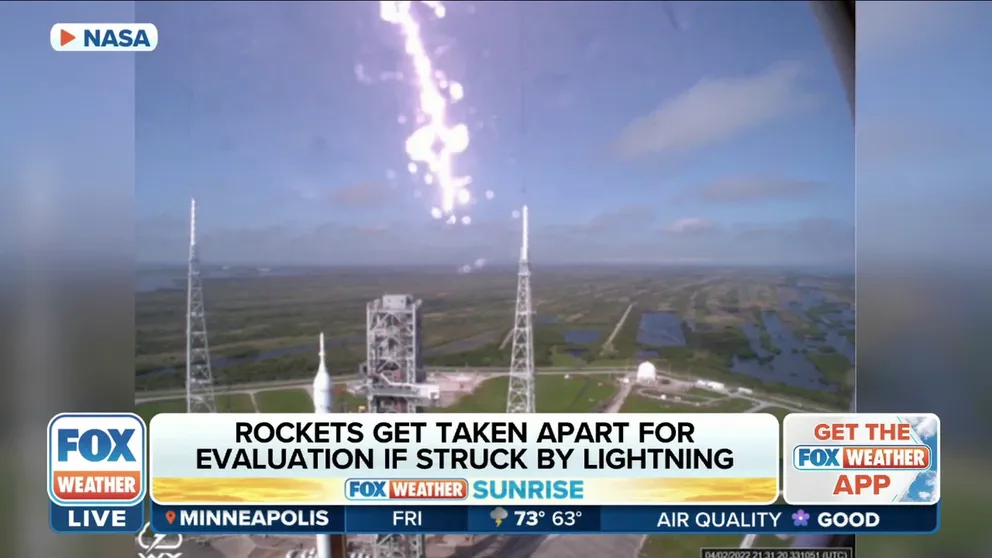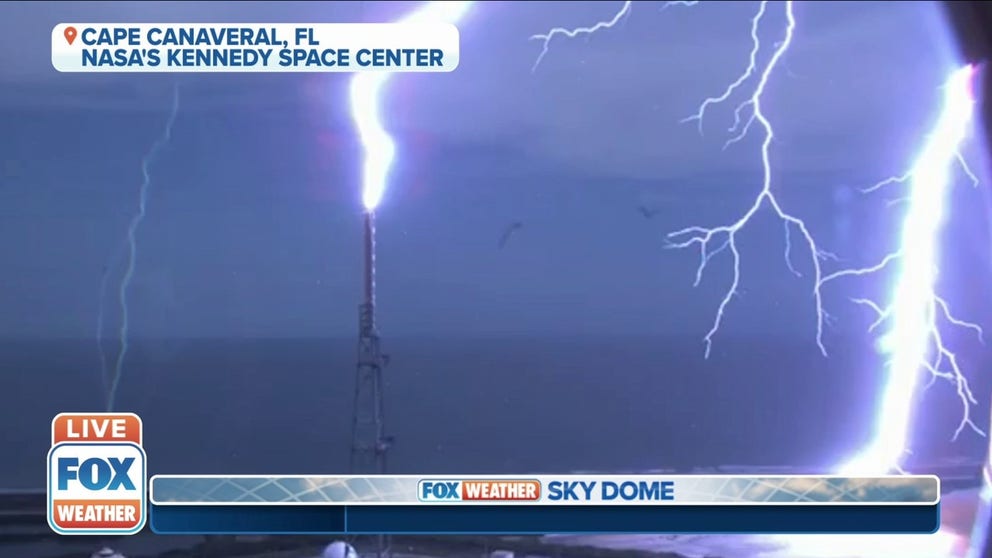Protecting payloads and people: How ULA launches rockets in the lightning capital of the US
Launchpad lightning protection systems, like the one at Space Launch Complex 41, divert lightning to the ground away from rockets and the billion-dollar spacecraft on board.
How ULA protects its rockets from lightning in Florida
Lightning is such a concern for scientists and engineers who work on Florida's Space Coast that they decided to invent a tool to protect themselves and their rockets from potential strikes. FOX Weather's Brandy Campbell got a look at ULA's Lightning Protection System.
CAPE CANAVERAL SPACE FORCE BASE, Fla. – Long before a rumble of thunder in the distance, forecasters are looking for potential lightning conditions miles away from a United Launch Alliance Atlas V rocket on the launchpad during a countdown.
As the clouds roll in and the tallest thing around is a 191-foot-tall rocket, that could spell danger for the vehicle and the payload, which might be a national security satellite, a Mars rover or soon, astronauts headed to the International Space Station. This is why ULA and all launchpads on Florida's Space Coast have lightning protection systems.
"The reason a lightning protection system is so important here is because we are dealing with very volatile chemicals. We are dealing with very sensitive materials," ULA rocket scientist Jim Kennedy said. "Though it might cost $100 million to get to space. The payloads, the satellites, these could be billions of dollars. You want all the protection you can for it."
At Space Launch Complex 41, Kennedy said that so far, the system is 100% successful in protecting the Atlas V rocket and its payloads from a direct strike.
"Everybody uses some form of it because it's a known issue, especially out here in Florida, where lightning is very common," he said. "We're very flat. There's nothing else to attract it other than us."
Data shows Florida experienced more lightning strikes in 2021 than anywhere else in the U.S. According to Vaisala, which tracks lightning data, the Sunshine State averages 223 strikes per square mile.
At 191 feet tall, the Atlas V is a target for lightning as storms roll through. Launch Complex 41 has a lightning protection system with tall steel masts around the rocket that can divert electrical current from it and safely carry it into the ground.
Four metal towers surround the launch tower, each with a white fiberglass insulator that Kennedy calls "candlesticks." A grid of wires goes directly above the rocket, and the web connects down to points on the ground. If lightning were to strike any of the points, the system creates the shortest path to the ground, diverting energy away from the rocket and nearby fueling tanks.

Four towers and wires part of the lightning protection system are seen around Launch Complex 41 where ULA launches the Atlas V rocket.
"It's in place to act as a Faraday cage for any of our equipment, personnel or the rocket, the payload, the ride to space there, when it's out here at the pad," Kennedy said of the enclosures used to block electromagnetic fields.
Not all lightning protection systems look the same. For some pads, a single poll might be enough for a tent-like effect of protection.
"Every pad has its own system. They're all doing the same thing," Kennedy said. "It's all the same calculations on how to protect it. It's just how is that pad is set up; what is the best way for it?"
Recently, the lightning protection system at Kennedy Space Center launchpad 39B, where NASA's Space Launch System rocket was standing tall, helped the mega moon rocket survive the strongest lightning strike ever recorded at KSC.
NASA's mega moon rocket survives most powerful lightning strike ever recorded at space center
The most powerful lightning strike ever recorded at NASA’s Kennedy Space Center recently put the Florida spaceport’s lightning protection system at Launch Pad 39B to the test.
The SLS 41 system was first implemented for the Titan rocket in the early 90s. When ULA shifted to the Atlas V rocket, teams inspected the ground rods and found that they had absorbed so much lightning the ground around the rods was fossilized.
"It was turned into glass, and they were no longer conductors. They were insulators," Kennedy recalled. "So we had to go through, dig up all our ground rods."
Kennedy said similar to modeling for a 100- or 1,000-year flood, engineers also look out for historic lightning strikes.
"We have the hundred-year lightning strike, the daily lightning strike, the thousand-year lightning strike, that perfect shot," Kennedy said. "It hasn't gotten through yet, but nothing is perfect outside of a solid metal sphere, but it would be hard to shoot rockets out of that."
Ahead of a launch and during a countdown, launch weather officers with the 45th Weather Squadron are in constant communication with ULA teams informing them of the conditions around Launch Complex 41, including if there has been a lightning strike within the area.
Rockets can trigger lightning during a launch if certain clouds are near the launch site, so launch forecasters monitor cumulus and anvil clouds in the area ahead of liftoff.
"The weather station at the base will tell us that our field is increasing, the energy in the air is increasing, and there's the likelihood," Kennedy said. "When (lightning) discharges, they say, 'OK, we have a discharge within (blank). They'll give us a distance within a quarter-mile of Complex 41 that we're at here. So it's saying it could have hit you, could have hit the ground."
The lightning protection system is designed to take a hit and is regularly maintained by technicians and inspected after potential strikes.
Soon, Space Launch Complex 41's lightning protection system will be put to use for a new launch vehicle as ULA begins launching its new Vulcan Centaur rocket.

